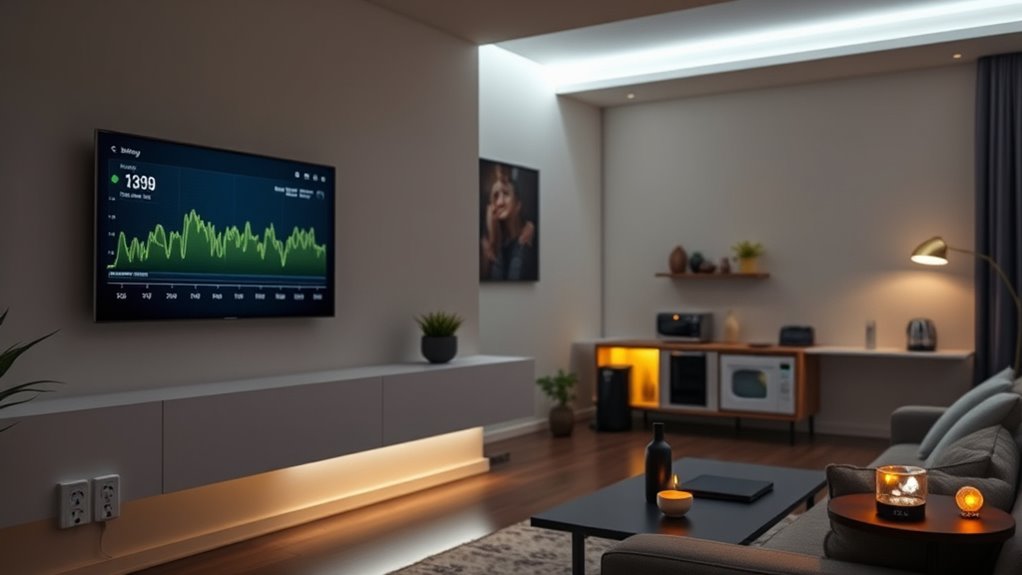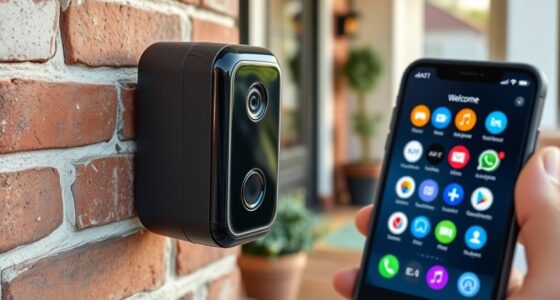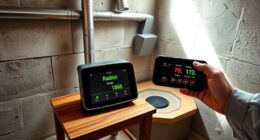Your smart home could be secretly driving up your electric bill through misconfigured devices, automation glitches, or inefficient use of lighting and thermostats. For instance, leaving lights on in unoccupied rooms or setting thermostats too high can waste energy, especially if automation routines malfunction. Manual overrides and outdated firmware can also cause devices to run longer than necessary. If you want to uncover hidden ways your smart home wastes power, keep exploring these common issues and solutions.
Key Takeaways
- Phantom energy drain from idle smart devices and background processes increases overall power consumption.
- Misconfigured automation routines and sensor glitches can cause devices to operate unnecessarily.
- Manual overrides and poor scheduling lead to inconsistent device usage and higher energy bills.
- Inefficient lighting and thermostat settings, combined with neglecting energy-saving features, waste electricity.
- Environmental issues like poor insulation and sensor placement reduce device efficiency and increase energy use.
Common Smart Devices That May Increase Energy Consumption
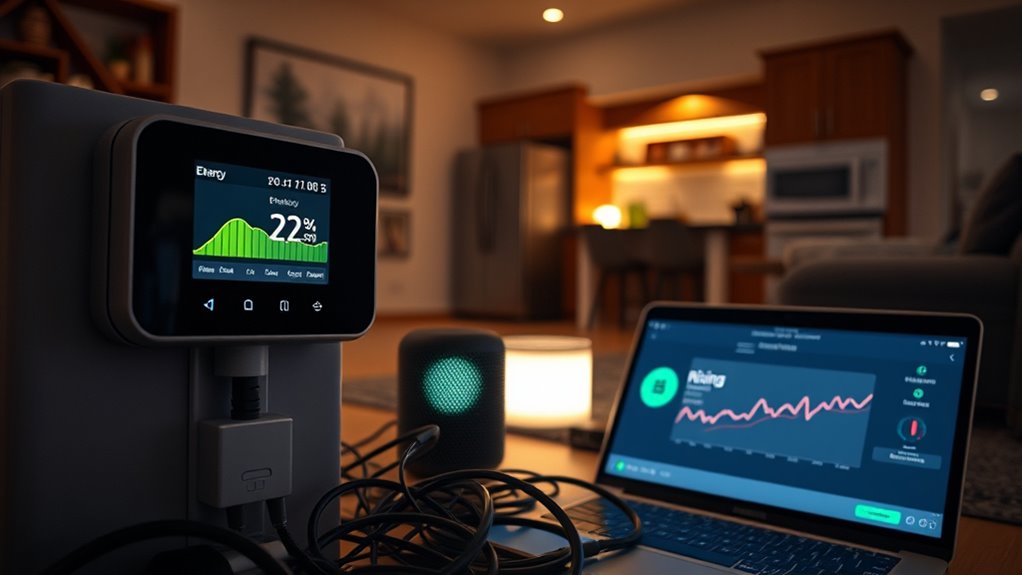
While smart devices offer convenience, some can unintentionally boost your energy bills. Many smart devices, like smart speakers and security cameras, draw power even when idle, increasing your overall energy consumption. Smart thermostats can also raise costs if set to maintain higher temperatures or run unnecessary heating and cooling cycles, wasting energy. Smart lighting systems with bright or color-changing features may consume more energy than traditional bulbs if left on or overused. Smart plugs and outlets can add to your bills if you forget to turn off connected devices, especially when managing multiple appliances. Additionally, automatic updates and data syncing run in the background, consuming extra energy. Proper power management and monitoring can help prevent these unnecessary energy drains and keep your bills in check. Incorporating energy-efficient settings into your smart devices can further reduce unnecessary consumption and save you money. Regularly reviewing device power usage helps identify which gadgets are contributing most to your energy costs, enabling more targeted adjustments. Understanding the power consumption patterns of your devices can also guide you in making smarter choices to optimize efficiency. Being aware of AI-driven discoveries in energy management can further enhance your ability to control energy use and reduce costs. Additionally, integrating smart energy monitoring tools can provide real-time insights, helping you make more informed decisions about your device usage.
Misconfigured Settings and Automation Glitches
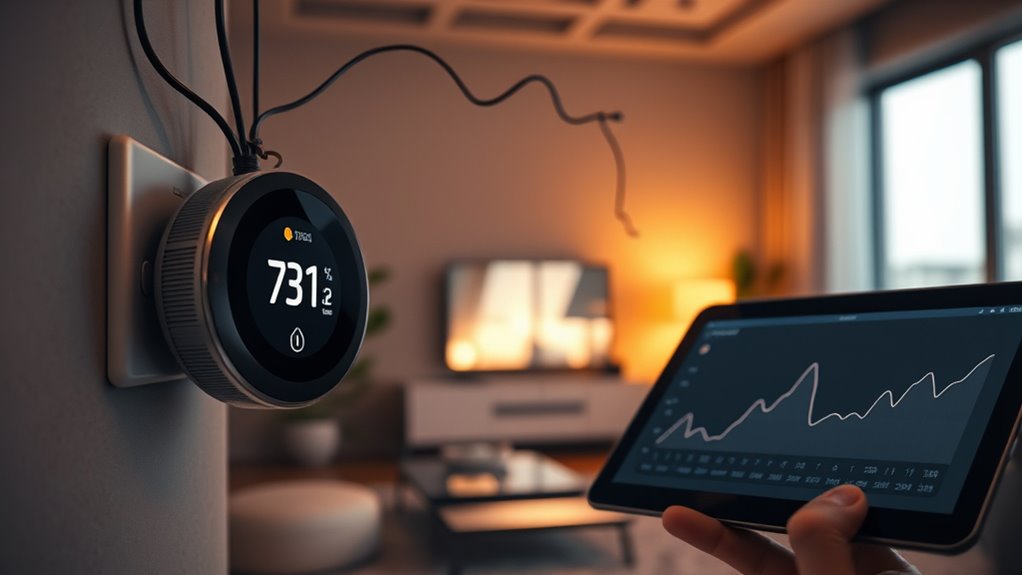
Misconfigured settings and automation glitches can substantially undermine the energy savings offered by smart home devices. When misconfigured settings cause overly aggressive temperature adjustments or incorrect scheduling, your smart devices may run longer than necessary, increasing energy consumption. Automation glitches, such as sensors malfunctioning or automation rules triggering unexpected operation, can turn lights on when no one’s around or activate HVAC systems during unoccupied periods. Firmware bugs or software errors can cause devices to behave erratically, further raising electricity costs. Overly sensitive sensors or faulty automation rules often trigger devices multiple times an hour, compounding energy waste. These issues highlight how improper setup and glitches can turn smart devices into unintentional energy drains, rather than savings tools. Vetted smart home devices may lack proper safety features or fail to incorporate essential energy-saving protocols, exacerbating these problems.
Inefficient Use of Smart Thermostats and Lighting
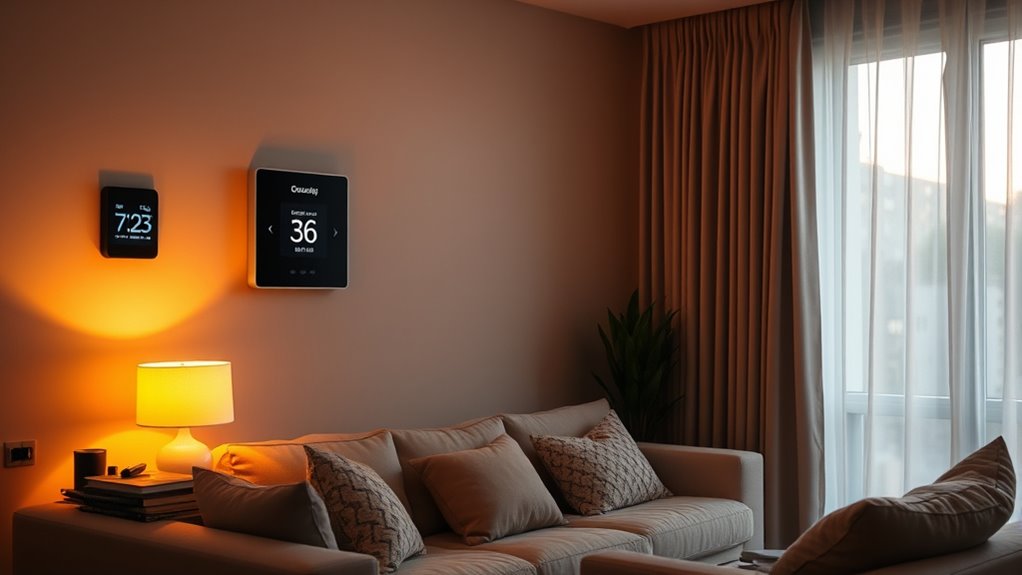
If you don’t set your smart thermostat correctly or frequently override it, you could be wasting energy and money. Leaving smart lights on or at high brightness when unnecessary also drives up your bills. By neglecting scheduling features and automation, you might be operating devices longer than needed, increasing your overall electricity costs. Additionally, understanding retail hours today can help you plan visits to stores that offer energy-efficient appliances or smart home devices at the right times. Being aware of smart device energy consumption can further help you optimize usage and reduce costs. Incorporating AI-powered optimization tools can enhance your energy management by automatically adjusting settings based on your habits and preferences. Recognizing the importance of proper device configuration ensures your smart home functions efficiently without unnecessary energy drain.
Misconfigured Temperature Settings
Have you ever noticed your energy bills climbing despite using smart thermostats and lighting? Misconfigured thermostats can cause increased energy consumption if temperature settings are too high or low, forcing your system into inefficient operation. This leads to higher heating and cooling costs and inflated energy bills. To avoid this, check that your sensors are properly calibrated and placed, ensuring accurate readings. Sensor placement is crucial for reliable temperature measurements; improper placement can cause your system to overcompensate and waste energy. Be cautious with automation routines—overriding them or setting inconsistent schedules can negate energy savings. Also, ensure your thermostat’s firmware is up-to-date, and avoid leaving it at extreme settings. Additionally, regularly reviewing your energy consumption patterns can help you identify inefficiencies and adjust settings accordingly. Incorporating system calibration techniques can further optimize your smart home’s energy efficiency. By fine-tuning these aspects, you can prevent wasteful heating and cooling, reduce utility costs, and keep your smart home devices working efficiently. Additionally, environmental considerations such as proper site selection and minimizing impact can help optimize overall energy use and efficiency. Incorporating creative problem-solving approaches can help troubleshoot and optimize your smart home system for maximum efficiency.
Overusing Smart Lighting Features
While adjusting your thermostat can help save energy, overusing smart lighting features often leads to higher electricity bills instead of reducing them. Relying heavily on smart lighting automation, like motion sensors, or making frequent manual adjustments can increase energy consumption. If lights stay on in unoccupied rooms or aren’t scheduled properly, you’ll waste electricity and drive up costs. Using inefficient bulbs with smart lighting amplifies unnecessary energy use, especially when lights remain on longer than needed. Additionally, leaving lights on in conjunction with smart thermostats that reduce heating or cooling can create conflicts, increasing overall energy use. To avoid higher electricity costs, set appropriate lighting schedules, maximize occupancy detection, and replace inefficient bulbs to ensure your smart lighting truly saves energy. Understanding energy-efficient technology options can further optimize your home’s power consumption and reduce bills. Moreover, improper use of smart home devices can undermine energy savings and lead to wasted resources. Incorporating smart energy management strategies can further enhance your home’s efficiency and cost savings. Being mindful of device automation settings helps prevent unnecessary energy drain and maximizes savings.
Neglecting Schedule Optimization
Are you maximizing your smart home devices’ potential to save energy? Neglecting schedule optimization can cause smart thermostats and automated lighting to run inefficiently, increasing your energy consumption. Without proper device schedules, your smart thermostats may heat or cool when no one’s home, wasting power. Leaving lighting on or set too high can also drive up utility bills unnecessarily. To improve, consider these key steps:
- Set and regularly update device schedules for thermostats and lighting.
- Use automation features like motion sensors and geofencing to turn devices off when unneeded.
- Customize energy-saving settings to prevent devices from running in the background.
- Understanding Eye Patch Benefits and how they can improve skin health may seem unrelated, but applying proper skincare routines can be part of a comprehensive self-care strategy that reduces stress and promotes better overall well-being, indirectly influencing energy use by encouraging healthier habits.
Neglecting these strategies means missing out on significant energy savings, which can impact your utility bills and overall device operation.
The Impact of Frequent Remote Controls and Manual Overrides
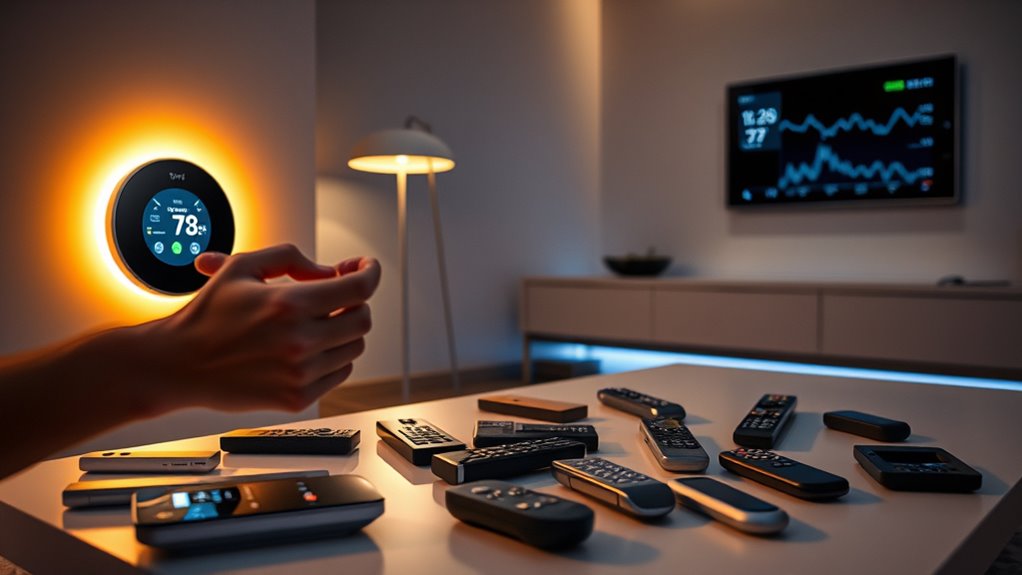
When you frequently adjust your smart devices manually, you may disrupt their energy-saving functions and cause increased utility bills. Constant remote controls and overrides prevent automation from working efficiently, leading to higher energy consumption. These habits can result in more device usage and less overall savings.
Excessive Manual Adjustments
Frequent manual adjustments of smart home devices can undermine their energy-saving potential. When you override automation, you disrupt optimized settings, causing unnecessary spikes in energy consumption. Repeated manual control of smart thermostats during off-hours often leads to higher energy bills—up to 15% more—by unnecessary heating or cooling. Additionally, toggling smart lighting or appliances outside scheduled routines not only increases energy use but also shortens device lifespan. To understand this better:
- Manual adjustments prevent smart devices from operating at peak efficiency.
- They cause inconsistent energy consumption, negating automation benefits.
- Overriding systems reduces energy savings and increases maintenance costs.
Disrupted Automation Settings
Manual overrides and remote controls can considerably undermine your smart home’s automation efficiencies. When you frequently adjust automation settings on smart devices, it causes automation disruption and prevents your system from functioning ideally. Manual overrides, like changing thermostat temperatures or turning lights on/off remotely, force your devices to reset their schedules, leading to system resets that reduce automation effectiveness. This inconsistent use of automation controls results in inefficient operation, as devices may run longer or more often than necessary. For example, overriding your smart sprinkler during rain wastes water and energy. These disruptions cause unexpected energy spikes and higher electricity bills, as your system struggles to adapt and operate smoothly. Ultimately, constant manual adjustments hinder your smart home’s ability to save energy and cut costs.
Increased Device Usage
Have you noticed that constantly adjusting your smart devices can lead to higher energy bills? Frequent remote controls and manual overrides disrupt optimized schedules, increasing energy consumption. When you manually adjust thermostats or turn smart appliances on and off, you often prevent devices from entering standby mode, which is vital for energy savings. Consider these points:
- Repeated manual overrides cause smart appliances to operate outside efficient settings.
- Using remote controls to frequently toggle devices prevents low-power standby modes.
- Habitual adjustments can increase overall energy use, raising electricity costs over time.
Your user behavior profoundly impacts device usage, often negating the benefits of automation. By overusing remote controls and manual overrides, you unintentionally boost energy consumption, making your smart home less efficient and more costly.
Overlooking Energy Wastage From Smart Plugs and Sensors
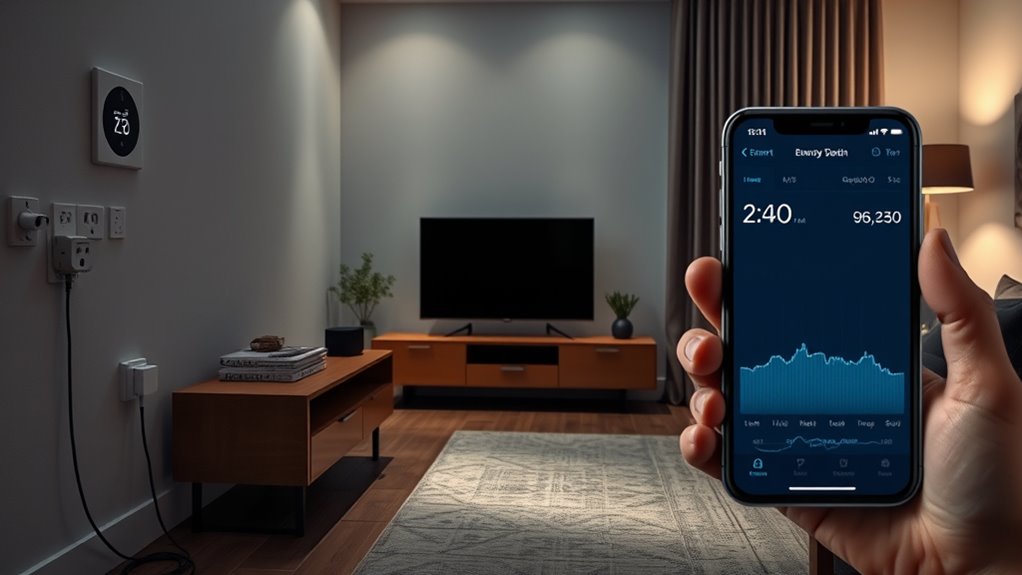
Many smart plugs and sensors continue to draw power even when your devices are turned off, silently increasing your energy bills through phantom energy. This standby power, often overlooked, adds up over time, leading to unnecessary energy wastage. Poorly configured smart plugs can consume extra energy, while sensors that activate unnecessarily increase device activation and energy use during periods when no one’s home. Without proper monitoring, these hidden energy drains can inflate your electric bills by 10-15%. Relying on sensors not optimized for energy efficiency causes needless appliance activation, wasting both energy and money. Many users underestimate the cumulative impact of multiple smart plugs and sensors running simultaneously. Addressing these overlooked sources of phantom energy is essential for improving overall home energy efficiency and reducing long-term costs.
Home Environment Factors Limiting Smart Device Efficiency
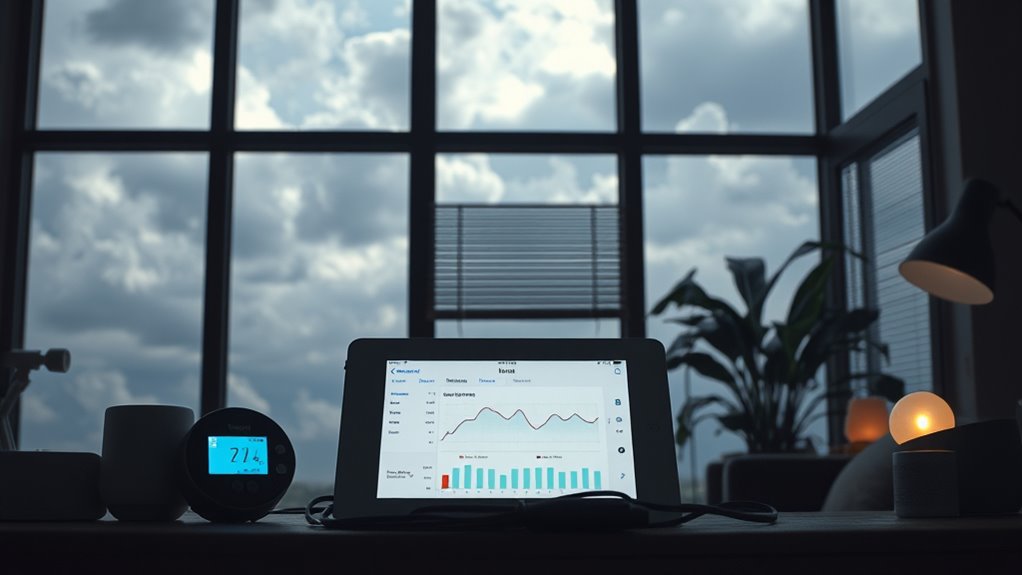
Your home environment plays a crucial role in determining how effectively smart devices operate. Factors like insulation, ventilation, and wiring can create inefficiencies that drive up energy use. Consider these key issues:
- Poor insulation and drafts cause smart thermostats to work harder, as temperature sensors misjudge actual conditions.
- Limited natural light leads to overuse of artificial lighting, reducing the efficiency of smart lighting systems.
- Outdated wiring hampers device communication, causing inconsistent operation and increased energy consumption.
Homes with high thermal mass or passive designs may resist temperature adjustments, making smart thermostats less effective. Structural issues, such as leaks or drafts, also compromise sensor accuracy, leading to unnecessary energy expenditure. These environment factors can undermine your smart home’s savings potential.
Tips for Ensuring Your Smart Home Saves Money
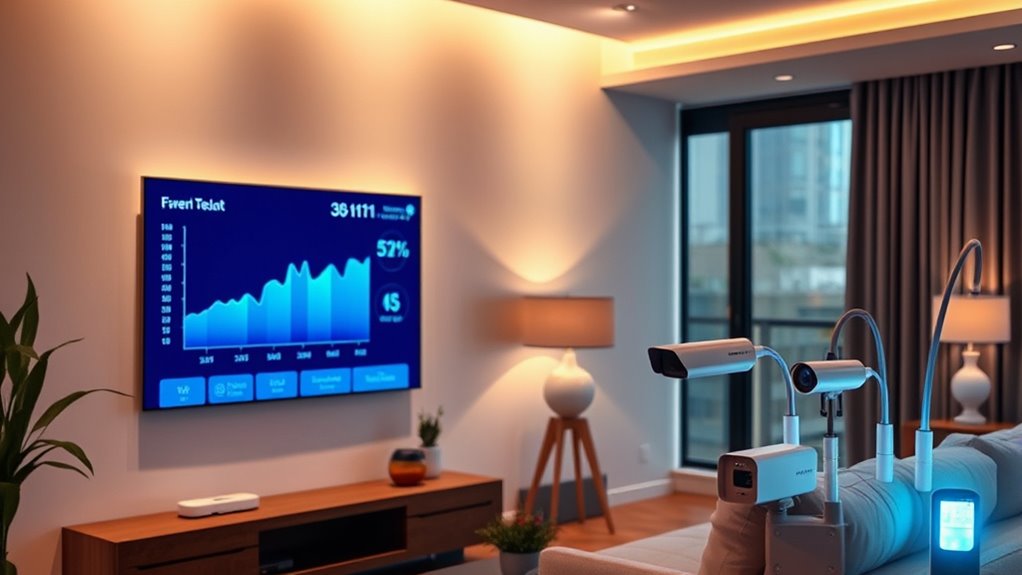
To maximize savings, it is essential to regularly review and adjust your smart devices’ settings so they don’t unnecessarily boost your energy bills. Use energy monitoring features to identify which smart devices consume the most power and optimize their usage. Proper device settings for thermostats, smart plugs, and lighting can help reduce energy consumption and prevent phantom energy drain from standby modes. Scheduling automation to operate only during needed times minimizes unnecessary operation and cuts energy costs. Keep firmware and software updated to guarantee devices run efficiently and avoid bugs that could increase energy use. An energy-efficient smart home isn’t just about having smart devices, but actively managing them to prevent overuse and unnecessary energy drain, ensuring your smart home truly saves money.
Frequently Asked Questions
Do Smart Homes Use a Lot of Electricity?
Smart homes do use a noticeable amount of electricity. You might not realize it, but devices like smart thermostats, security cameras, and lighting systems run their processors and stay connected constantly. Their standby modes still draw power, and your Wi-Fi router and hubs stay on all the time. Over time, these small, continuous consumptions add up, potentially increasing your overall energy bill despite energy-saving features.
What Runs Your Electric Bill up the Most?
Your electric bill goes up mostly because of how you use smart devices. If your smart thermostat runs your HVAC system too often, it eats more energy. Leaving smart plugs on high-energy appliances or lights in empty rooms wastes power. Continuous operation of security cameras and doorbells also adds up. Plus, high standby power from some gadgets can silently increase your bills over time. Managing these devices wisely helps keep your costs down.
What Are the Disadvantages of a Smart Home?
Imagine your smart home’s energy use spikes unexpectedly, like in a case where smart hubs and cameras stay on 24/7, increasing your bills. The disadvantages include higher energy consumption from continuous device operation, overuse of automation leading to unnecessary power draw, and poor system integration causing overlapping functions. These issues can offset savings, making your smart home more costly and less efficient than you might expect.
How Smart Home Technology Affects Energy Consumption?
Smart home technology influences your energy consumption by often increasing it unintentionally. Devices like smart speakers and security cameras run continuously or stay on standby, consuming power. Overusing smart lighting or improperly setting thermostats can lead to higher bills. Even smart plugs may draw energy when devices are in standby mode. To prevent this, you need to optimize and carefully manage your smart devices, ensuring they operate efficiently and don’t drive up costs.
Conclusion
If you ignore these smart home pitfalls, your energy bills could skyrocket to impossible heights, turning your futuristic house into a money-draining monster. Don’t let hidden glitches and wasted energy turn your smart tech into a financial nightmare. Take control now—double-check your settings, optimize device use, and stop those sneaky power drains before your electric bill becomes an unstoppable beast. Your wallet will thank you, and your smart home will finally work for you, not against you.
